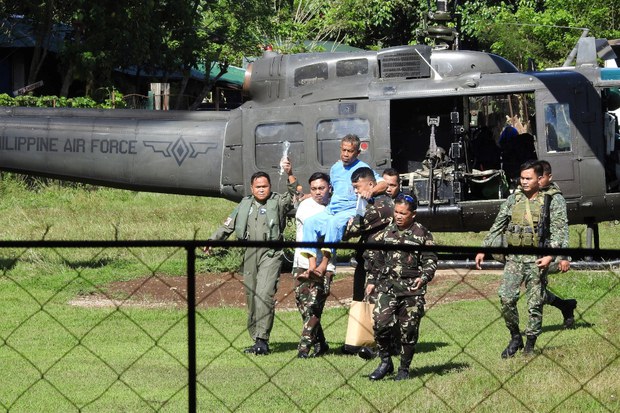Philippine Govt Forces Kill Abu Sayyaf Suspects in Latest Southern Clash
2020.05.04
Cotabato, Philippines
 Malaysian seaman Abdurahim bin Sumas (in blue) is carried by soldiers out of a helicopter that took him to a military hospital in Jolo town in the southern Philippines after security forces rescued him and another Malaysian from suspected militants, March 23, 2017.
Malaysian seaman Abdurahim bin Sumas (in blue) is carried by soldiers out of a helicopter that took him to a military hospital in Jolo town in the southern Philippines after security forces rescued him and another Malaysian from suspected militants, March 23, 2017.
Philippine security forces killed two suspected members of Abu Sayyaf, a pro-Islamic State militant group, in a clash during the weekend on far southern Tawi-Tawi Island, according to information released by the military Monday.
The violence took place amid an intensified manhunt by government forces against militants in the south, more than two weeks after 11 soldiers died in a firefight with an Abu Sayyaf band commanded by Hatib Hajan Sawadjaan, the new leader of Islamic State (IS) in the Philippines.
A gunbattle ensued after a combined unit of Philippine marines and local police ran into an undetermined number of Abu Sayyaf fighters while out on patrol on Sunday, said Col. Arturo Rojas, commander of the Joint Task Force Tawi-Tawi.
Two of the gunmen, identified as Jul Haber and Kamsel Ampang, were killed after a 10-minute firefight, Rojas noted in his incident report.
Haber, apart from being a known a member of an Abu Sayyaf wing with links to IS, was also wanted for drug trafficking, Rojas wrote. Soldiers recovered an M16 rifle, dozens of rounds of ammunition, rifle magazines and a rifle grenade from the firefight scene, he said.
Lt. Gen. Cirilito Sobejana, the regional military chief, said the bodies of the suspected militants were turned over to a municipal police station.
“Let us continue to collaborate, fight terrorism and criminalities, and work for peace in the communities,” Sobejana told reporters.
On April 23, government forces killed at least six suspected Abu Sayyaf militants in a gunbattle that also left eight soldiers wounded near Patikul town in Sulu, another island-province in the southern Philippines, the military said. That operation followed a firefight with Abu Sayyaf gunmen on April 17 that left 11 soldiers dead and 14 others wounded on the military’s side in Jolo, the main island in Sulu province.
The Abu Sayyaf Group (ASG) is the smallest of several armed groups operating in the southern Philippines, but is considered the most brutal one. It has been involved in the abduction of foreigners and local missionaries, some of whom the militants beheaded after their relatives failed to pay ransom.
One of ASG’s leaders, Isnilon Hapilon, later allied himself with IS, and in 2017 launched a daring raid on the southern city of Marawi. Backed by hundreds of fighters from Southeast Asia and the Middle East, the militants took over the lakeshore city and battled security forces for five months.
Hapilon was later killed at the end of the battle, but military officials said several fighters may have escaped and regrouped in mountainous areas. Hapilon was later replaced by Sawadjaan as the new IS leader in the Philippine south. Little is known about him, except that he is a spiritual leader of the Abu Sayyaf and was a contemporary of the original Abu Sayyaf fighters on Jolo.
The military said Sawadjaan planned twin bombings at Jolo’s cathedral in January 2019 using two Indonesians, in a suicide attack that killed 23 people.







